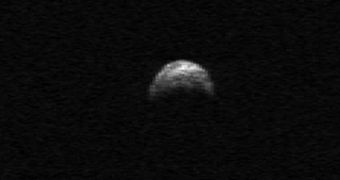Astronomers announce that skywatchers will have the opportunity this year to witness an interesting cosmic event. The massive space rock that is expected to whirl past our planet in November is one of the largest, potentially-harmful such structures ever detected.
When experts say potentially dangerous, they mean that the rock could have its orbit altered in the future, in such a way that it will become a direct threat to our well-being. But this is not the case during this year's pass, they add.
The asteroid is called 2005 YU55, and it has a diameter of 400 meters (1,300 feet). The reason why its pass will be so spectacular in 2011 is that it will move closer than 0.85 lunar distances to Earth's surface, Space reports.
In order to make the best out of this scenario, investigators have already planned to conduct a sustained scientific investigations campaign during the days immediately before and after the close pass.
Radar, visual and infrared observations will be conducted from a number of locations around the world, that will have a clear view of the cosmic event. The space rock was detected a little less than 6 years ago by the Skywatch initiative.
The project is based at the University of Arizona in Tucson (UAT) Lunar and Planetary Laboratory. Experts working here say that it's unusual for such large asteroids to stray so close to our planet.
“The close Earth approach of 2005 YU55 on November 8 is unusual since it is close and big. On average, one wouldn’t expect an object this big to pass this close but every 30 years,” says expert Don Yeomans.
He holds an appointment as the manager of the NASA Jet Propulsion Laboratory's (JPL) Near-Earth Object Program Office. The expert reveals that the radar capabilities of the NASA Deep Space Antenna, in Goldstone, California, will definitely be employed to study the space rock.
“So we like to think of this opportunity as a close flyby mission with Earth as the spacecraft. When combined with ground-based optical and near-infrared observations, the radar data should provide a fairly complete picture of one of the larger potentially hazardous asteroids,” Yeomans explains.
“We’re already preparing for the 2005 YU55 flyby. The asteroid will approach from the south, so Goldstone has the first chance to observe it due to its declination coverage,” adds JPL research scientist Lance Benner, who specializes in NEO radar imaging.

 14 DAY TRIAL //
14 DAY TRIAL //